#oseberg ship
Explore tagged Tumblr posts
Text

Excavation of the Oseberg Ship 1904
On 8 August 1903, the archaeologist Gabriel Gustafson received a visit from Oskar Rom, a farmer who had dug into a large burial mound on his property and had come across the remains of a ship. The special thing about this ship - it is the grave of two women from the year 834 AD.
Two days later Professor Gustafson started his investigations at the farm of Lille Oseberg at Slagen in the county of Vestfold. He found several parts of a ship, decorated with ornamentation from the Viking era.
The archaeologist was certain that the mound was a ship burial from Viking times. But to avoid problems with the autumn weather, the archaeologists waited until the following summer before starting the dig in earnest. The excavation of the Oseberg mound was of great interest to the public.
The dig had to be secured with a fence, signs and a guard to ensure that nobody interrupted the work or came too close to the objects. In his diary, Gustafson complains about being on show when heworked.
When the excavation was completed, the most time-consuming and demanding work was still to come. Although the excavation itself took less than three months, it took 21 years to prepare and restore the ship and most of the finds.
The ship was dried out very slowly before it was put together. Great emphasis was placed on using the original timber where possible. Today over 90 per cent of the reconstructed Oseberg ship consists of original timber.
#naval history#naval artifacts#oseberg ship#viking ship#early 20th century#excavation#8th century ad#medieval seafaring
79 notes
·
View notes
Text

The Oseberg ship
13 notes
·
View notes
Text

The #osebergship (Norwegian: Osebergskipet) is a well-preserved Viking ship discovered in a large burial mound at the Oseberg farm near Tønsberg in Vestfold county, Norway. This ship is commonly acknowledged to be among the finest artifacts to have survived from the Viking Age. The ship and some of its contents are displayed at the Viking Ship Museum at Bygdøy on the western side of Oslo, Norway.[1]
0 notes
Text
Some time ago, I was doing chores while watching a documentary about ancient burial rites (to be precise, it was episode three of the Mysteries of the Ancient Dead series; yes, this is a normal thing for me to do).
But shortly after the beginning of the episode, the topic went to an old Viking ship called the Oseberg that was used for a burial. On it: Two female bodies from the 9th century, sharing a bed in this noble grave. One wealthy woman in her eighties, plus a woman in her fifties.
And while the experts in the documentary went through all the possible theories (Was the mystery middle-aged woman a relative? A fellow noblewoman? A slave that was sacrificed for her deceased mistress?), I found myself pausing my chores, sitting down in front of my tablet, feet kicking the air and head rested on my hands like
Oh Please Tell Me More
About Viking Sappho and Her Friend.
Some nice summary can be found at Wikipedia:
And as a little bonus, a screenshot from the documentary showing a pic of Odin in a mood quite as gleeful as mine:

#sappho and her friend#oseberg ship#burial#burial rites#viking#odin#fun with history#mysteries of the ancient dead#mysteries of the ancient dead e03
1 note
·
View note
Text
so this is a form of weaving called tablet weaving! it’s a process where cards (usually wooden) are turned a quarter turn in order to separate the warp and create different patterns. this type of weaving has been around since at least the 8th century BCE, so around the iron age, and notable examples include the hallstatt salt mine:

which dates back to the 8th century like i mentioned and the oseberg ship:

a viking burial mound and ship that dates back to at least 834, and even includes what appears to be an entire set of tablets!
long story short, this is a very old form of weaving, which is actually quite easy and cost-effective to learn! if you’re interested, i recommend elewys of finchingefeld’s video on it, and honestly her whole channel!
good luck weaving!
weave with me ASMR
1K notes
·
View notes
Text

Oseberg Viking ship on a vintage postcard
#postal#historic#ansichtskarte#sepia#vintage#oseberg#tarjeta#viking#briefkaart#photo#ship#oseberg viking#postkaart#ephemera#postcard#postkarte#photography#carte postale
18 notes
·
View notes
Text
Kicking off a new tablet weave 😊

Fun lil band pattern based on card woven belt scraps recovered from the Oseberg Ship Burial in Norway, one of the richest sources of textile archeological finds from the early medieval period.
#tablet weaving#card weaving#fiber arts#textile history#textile arts#Oseberg Ship burial#weaving history
29 notes
·
View notes
Text
Y'all I just finished my first tablet woven belt and it looks so cool!! I wanted to go for a flame vibes, and I think I nailed it with the colors. The pattern itself is a recreation of one of the patterned weavings found in the Viking Oseberg Ship Burial!
My sister helped me warp the loom bc I suck at putting the cards on the correct way(great at wrapping the cords around the loom, I just fuck up the threading the cards part often lmao), but I did all of the actual weaving on it myself, and I'm decently happy with it. I messed up ina few spots, but it's also only my first time weaving something on my own lmao.
I think next time I might use better contrasting colors since the orange and red kinda don't contrast too well, but live and learn lmao, I still like it, janky transitions and errors included lmao!


#sca#society of creative anachronism#tablet weaving#weaving#loom weaving#loom#looms#tablet woven belt#crafting#crafts#art#medieval art#middle ages#join your local sca it's great#seriously you learn so much cool shit#oseberg weaving#oseberg viking ship#oseberg tablet weaving#I think it's 12L?#I might be wrong tho
16 notes
·
View notes
Text


the little joys of immortality
#04 linnanmäki#2018#🦇 einarr#🦇 morten#throwing shade at oslo we love to see it#tbh it's very unlikely that the ship he traveled with was any of the major ship finds like oseberg and gokstad#but also this is fictional norway and this could be a fictional ship that was also found#who knows!!#it's a fun idea#low stakes 🦇#📗 bonus bits
13 notes
·
View notes
Text

Figurehead from the Oseberg ship, about 800 AD; in the Museum of National Antiquities, Oslo
136 notes
·
View notes
Text
Preparing funeral for viking queen? The Oseberg ship.
The skeletons of two women were found in the grave with the ship. One, probably aged around 80, suffered badly from arthritis. The older woman also had Morgagni's syndrome, which would have given her a masculine appearance and beard.[8] The second was initially believed to be aged 25–30, but analysis of tooth-root translucency suggests she was older (aged 50–55).[9] It is not clear which one was the more important in life or whether one was sacrificed to accompany the other in death. The younger woman had a broken collarbone, initially thought to be evidence that she was a human sacrifice, but closer examination showed that the bone had been healing for several weeks. The opulence of the burial rite and the grave-goods suggests that this was a burial of very high status. One woman wore a very fine red wool dress with a lozengetwill pattern (a luxury commodity) and a fine white linen veil in a gauze weave, while the other wore a plainer blue wool dress with a wool veil, possibly showing some stratification in their social status. Neither woman wore anything entirely made of silk, although small silk strips were appliqued onto a tunic worn under the red dress.[10][failed verification]

21 notes
·
View notes
Text

Oseberg Ship, Viking Ship Museum, Oslo
1K notes
·
View notes
Text
Did Christianity Steal From Paganism? Yes... No... It's Complicated. Part 2: Vikings
Tis the season so I figured I'd talk about the topic that's been the subject of debate for a long time, most recently with the 2024 Olympics. I will be discussing the visual aspect of these religions, not the theological aspects.
Short answer: Yes
Long answer: No
Let's get into it: The Viking era is from 800-1050 AD and can be divided into seven parts based off the style of visual art that was popular. The first style is called the Oseberg style (775-800 AD) and would be the basis of all the Viking styles of art after it. It was made of three forms that were derived from Pagan pre-Viking art: ribbon animals, gripping beasts, and ambiguous forms. You can see it on the bow of the ship below; the ship dates to the 9th century and was found in a burial mound in Tønsberg, Norway. Remember these forms because they're going to be important later.

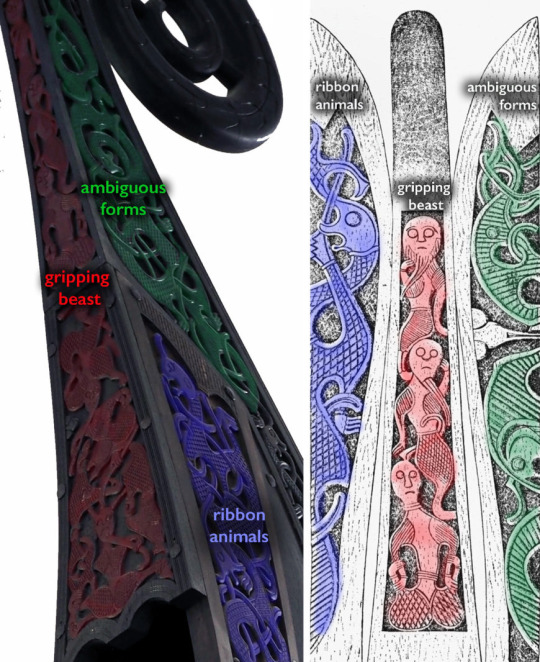
The Vikings started coming into contact with Christian Anglo Saxon (modern day English) missionaries in the 700-800s, but they had little effect. The missionaries were well received by the kings but when their Pagan chieftains threatened to rescind their support, the missionaries were sent away. Another example of that is in 878 AD, the Christian king of the Anglo Saxons, Alfred the Great of Wessex, and the Pagan king of the Vikings, Guthrum the Old, were at war. King Alfred ended up winning and as part of the peace treaty, Guthrum had to get baptized into Christianity. He did so but maintained his Pagan worship and did not implement Christianity.
Besides the kings, common people had also started to slowly assimilate to Christianity. Christians had a rule that they couldn't trade with Pagans so Pagan Vikings began primsigning. Primsigning is an old Norse word meaning "to make the sign of the cross," the way to show you followed Christian beliefs before converting all the way through baptism. Even though they weren't being baptized and were still practicing Paganism, primsigning was enough for Christians to feel comfortable trading with them and brought the Vikings more into the world of Christianity.
An interesting example of this is in Kopparsvik, Sweden, where a large number of Viking individuals were buried in a prone position from 900-1050 AD. This is completely different from traditional Pagan Viking burials: there were no grave goods, no animal sacrifices, no mighty ships. Typically, a prone position is a sign of showing humility towards God and all the figures had notches carved into their teeth (below). Historians theorize that they used the notches to secretly signal to Christian merchants that they were also Christian to get discounts while not being alienated from their Pagan communities.
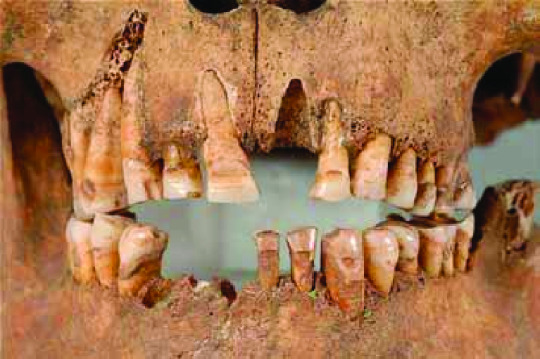
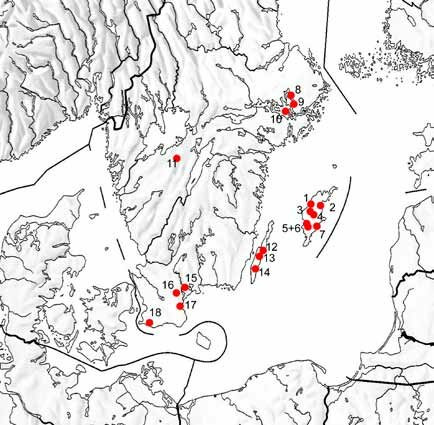
The coin below is from ~921 AD. It's a Viking coin from York, England and wonderfully shows the mixing of Pagan and Christian iconography. Coins like this typically had the name of the Viking king engraved on them but this one has "St. Peter." However, it also depicts the hammer of Thor on both the head (left) and reverse (right). It really demonstrates the visual mixing of religions.


Sometime between 940-1000 AD, the cross below was made. It was found in St Andrew's Church, Andreas, Isle of Man (between England and Ireland), and is another great example of the combination of Pagan and Christian art. On one side (left) it depicts Odin with one of his ravens fighting the wolf Fenrir at Ragnarök. The other side (right) depicts Christ triumphing over Satan. Both of these are stories of good vs evil and depict a god triumphing at the end of days. It would have drawn attention to the theological similarities between Christianity and Norse Paganism, making it easier for people to conflate the differing theologies.
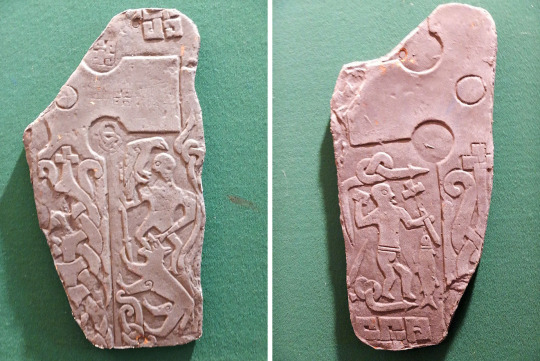
Remember the Oseberg style from before? We're going to revisit it. By the 900s, Viking art was being done in the Mamman style; the ribbon animals and gripping beasts had combined into an icon called the Great Beast. The Great Beast was a symbol of power and strength, frequently put on longships and other Pagan items. In 986 AD, Viking King Bluetooth, a recent convert to Christianity, had the jelling stone below erected in honor of his deceased parents. On one side, he included a Great Beast; this was to show the strength and nobility of his parents and the nation they ruled. On the other side, he put an image of Christ Triumphant. This makes sense for a cenotaph as the promise of a resurrection is a comfort in the face of death. But the combination of a Pagan symbol of strength and an image of Christ is very interesting; it's doing more than pointing out the similarities between the two religions, it's uniting both Pagan and Christian subjects under his rule and proudly displaying the two different sources of the Viking's strength.
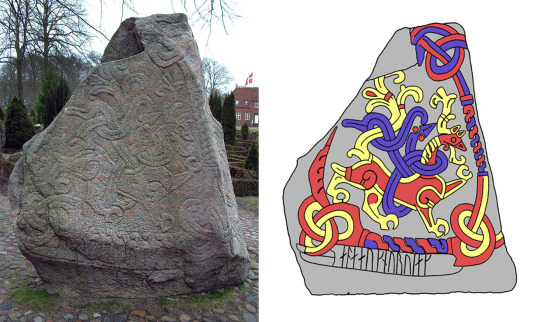

I can't end this without also talking about architecture. The last Viking art style is called the Urnes style and it's primarily because of the church below. It was built in 1132 AD in Urnes, Norway and is a stave church, meaning the whole thing was built without any nails!! The entire thing is self-supporting wood made using the post and lintel system. It's a Chrisitan church but has Pagan iconography on the sides: the last version of the Great Beast (right) and Pagan runes. It's fascinating how a Christian place of worship is decorated and protected by Pagan icons, once again showing the combination of visual cultures and methods of thought.

So, the answer everyone is looking for is NO.
The Christians didn't steal anything from the Pagans, they made an association. They produced art in the style that was popular and followed the artistic trends of the time. Christian and Pagan imagery was produced in the same medium and combined until Paganism was phased out over hundreds of years. They saw similar gods and iconography and combined them to make a message that was understandable to all audiences.
Happy Yule! Happy Winter Solstice!
Further reading:
Smarthistory – Art of the Viking Age
BBC - History - Ancient History in depth: Viking Religion
The Vikings and Christianity | History of Christian Vikings – Sons of Vikings
Treaty of Wedmore - Wikipedia
Manx runestones - Wikipedia
Prone Burials and Modified Teeth at the Viking Age Cemetery of Kopparsvik - Historische Beratung Dr. Matthias Toplak
Ancient Viking Art - Medievalists.net
Gamla Uppsala - Wikipedia
#i tried to include both academic and general further readings#this is very simplified bc i'm trying to give a general overview#yule#artist talk#ancient art#pagan witch#paganism#pagan#paganblr#christianity#norse paganism#celtic paganism#norse mythology#celtic mythology#norse art#celtic art#scandinavian folklore#scandinavian mythology#thor#odin#jesus christ#norse heathen#heathenism#winter solstice
63 notes
·
View notes
Text

1904: Excavation of the 'Oseberg Ship', a Viking Longship of the 9th century. Norway, .
Visit: BLOG
939 notes
·
View notes
Text

Oseberg Viking ship on a vintage postcard
#postal#historic#ansichtskarte#sepia#vintage#oseberg#tarjeta#viking#briefkaart#photo#ship#oseberg viking#postkaart#ephemera#postcard#postkarte#photography#carte postale
12 notes
·
View notes
Text
229 notes
·
View notes